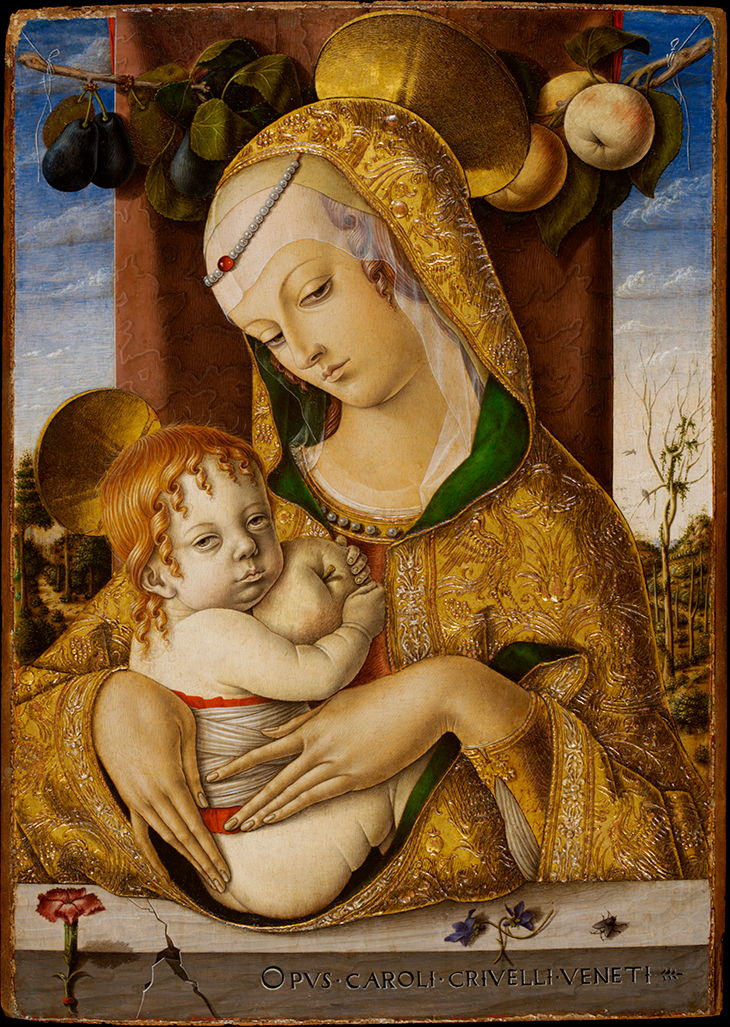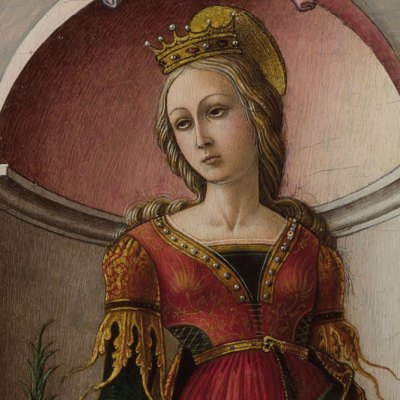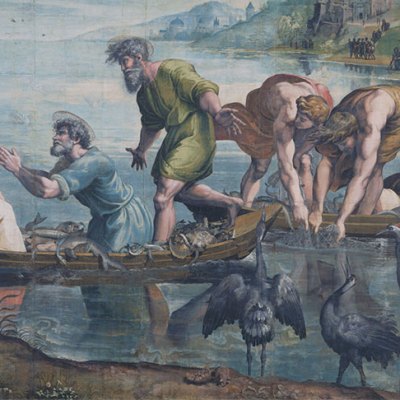A woman rests her infant child on a marble ledge before her. Her hands hold him close as she tucks him into the green silk lining of her luxurious gold brocade cloak, keeping his skin from touching the cold surface of the wall. Her gaze is soft, and falls downwards, not quite meeting the viewer’s eye. The child cradles an apple, symbol of the Fall of Man, and stares directly out of the panel to meet the gaze of the viewer. His golden, perfectly curled, tendrils hang about his face. This tender image is breathtaking for its technical virtuosity: the design on the cloth is embossed using pastiglia (or ‘pastework’, in which gesso is used to build up a surface), which is then covered with shimmering gold leaf; the veil around the woman’s face is tissue-like in its delicate transparency. It is a sumptuous glorification of the Madonna and Child.
Virgin and Child (c. 1480), Carlo Crivelli. Photo: © Victoria and Albert Museum, London

But all is not as it seems. Look more closely at the background, and you will see that mother and child are simply players upon a carefully constructed stage. The red mantle behind the pair is held up over a beam; the bower of fruit above their heads is held up using pieces of string.
This Virgin and Child (c. 1480) is one of nine works by Carlo Crivelli that make up ‘Shadows on the Sky’, a celebration of the often-overlooked Renaissance painter at Ikon Gallery in Birmingham (until 29 May). Born in Venice, and trained in Padua, Crivelli worked predominantly in Le Marche. Though he was successful in his lifetime, his work quickly fell out of favour – he was even left out of Vasari’s Lives of the Most Excellent Painters, Sculptors, and Architects – and his striking individuality has made him a difficult artist to place in the Italian Renaissance. Hosting a Crivelli show at Ikon has been a dream of the gallery’s director, Jonathan Watkins, for some 30 years; it has finally been realised with the help of the inaugural Ampersand Foundation Award, a biennial prize that provides £150,000 for UK institution to realise an exhibition and its catalogue, which Ikon won in 2019. Works by the Venetian master have travelled to Birmingham from institutions in Germany, Italy, and London. Among them are a loan from the Wallace Collection: the second work the museum has loaned in its history, and the first to leave London.
St Catherine of Alexandria (c. 1491–94), Carlo Crivelli. National Gallery, London

At the heart of the exhibition is an exploration of Crivelli’s use of trompe l’oeil – the attempt to trick the viewer, by means of optical illusion, into thinking that what they are looking at exists in three dimensions. The technique is playfully employed in each of the nine paintings. Saint Benedict (c. 1490), immersed in reading, hovers with his foot poised, ready to step out of the panel; on the internal frame of Crivelli’s Saint Catherine of Alexandria (c. 1491–94) sits a fly that is so realistic you want to swat it away. Trompe l’oeil can be found in paintings from throughout the period, but Crivelli’s use of it went beyond his contemporaries. His paintings do not just deceive; they actively draw attention to the means by which they do so. Perched on a step in the foreground of The Annunciation, with Saint Emidius (1486) are a cucumber and a piece of fruit, as though to suggest that Crivelli has left behind his afternoon snack; in the Vision of the Blessed Gabriele (c. 1489), a shadow cast by a string of fruit draws attention to the fact that the bright blue sky is actually a painted surface.
The Annunciation, with Saint Emidius (1486), Carlo Crivelli. Photo: © National Gallery, London

Turning trompe l’oeil on its head, Crivelli makes us aware at every turn that these are representations of reality, not reality itself. These manipulations of pictorial space and perspective often disorient, but they also direct us to consider the nature of painting as artifice, and to think critically about what we are being asked to see. That the exhibition gives the paintings so much space – very small panels have huge walls to themselves – invites the viewer to spend more time with each one, working through the layers of representation.
The Vision of the Blessed Gabriele (c. 1489), Carlo Crivelli. Photo: © National Gallery, London

Alongside the 15th century sit pieces by the contemporary artist, Susan Collis, whose work follows Crivelli’s in exploring the possibilities of trompe l’oeil. Walking through the exhibition you would be forgiven for thinking that you had stumbled upon it halfway through installation: a paint-splattered broom sits against the wall, surrounded by a dust sheet; hooks sit waiting for a painting to be hung on them. But on closer inspection, the paint on the broom is not paint at all but pearls, garnets and black diamonds, painstakingly embedded into the wood. The hooks are hallmarked silver or jasper. These were not part of the original plan for the exhibition; they have replaced works by Crivelli that were prevented from travelling through difficulties that have arisen because of Brexit and Covid. But they encapsulate Crivelli’s spirit.
This merging of old and modern is also in keeping with the values of Ikon, which seeks to make what Watkins describes as ‘historical interventions’ in contemporary spaces. Other aspects of the exhibition design reflect this: there is little in the way of guiding information, and the paintings hang on sparse white walls. It would be impossible to view these in an ‘original’ context – some were part of larger altarpieces that have since been broken up; the extraordinary amounts of gold leaf Crivelli uses were intended to catch the candlelight that illuminated them, making the figures appear to move. But the exhibition makes a virtue of necessity. The paintings are asked to speak for themselves, and the viewer is encouraged to discover Crivelli in their own way. There is certainly a great deal to be found.
Saint Mary Magdalene (c. 1491–94), Carlo Crivelli. Photo: © National Gallery, London

‘Carlo Crivelli: Shadows on the Sky’ is at Ikon, Birmingham, until 29 May.



